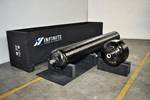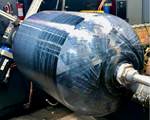Infinite Composites, ORNL to advance long-term H2 storage
Collaboration will build on the company’s existing 700-bar composite tanks, studying barrier material development and manufacturing optimization with the goal of driving tank adoption.
Composite pressure vessel technology company Infinite Composites Inc. (Tulsa, Okla., U.S.) has announced a cooperative research and development agreement (CRADA) with Oak Ridge National Laboratory (ORNL, Oak Ridge, Tenn., U.S.) to advance the manufacturing of hydrogen storage tanks for long-term storage and high-rate production.
This collaboration aims to further develop lightweight, high-pressure tanks that surpass current Department of Energy (DOE) gravimetric efficiency targets. The project will focus on optimizing Infinite Composites’ hydrogen storage tank capable of operating at 700-bar pressure, significantly improving upon existing composite tank options.
Potential key innovations of this research include:
- Development of integral gas barrier materials to replace permeation barrier layers
- Application of novel, high-aspect ratio 2D nanofiller-based barrier coatings
- Use of additive manufacturing techniques to aid tank production.
“This partnership with ORNL represents a significant step forward in our mission to revolutionize composite pressure vessel technology,” Matt Villarreal, CEO of Infinite Composites, states. “By developing new materials and processes for our hydrogen tanks, we aim to address the challenges of long-term hydrogen storage and accelerate to the growth of the hydrogen economy.”
In 2023 the global hydrogen market generated more than $242 billion in revenue and is expected to grow at a 7.8% compound annual growth rate until 2030, where revenues are projected to reach more than $410 billion.
“Advanced manufacturing techniques can drive the adoption of hydrogen storage tanks by improving production efficiency, reducing costs and enhancing performance,” adds Dr. Ahmed Arabi Hassen, group leader for composites innovation at ORNL. “These innovations can enable scalable, lightweight solutions, accelerating industry-wide adoption for a sustainable energy future.”
The research will be conducted in two phases, focusing on barrier material development and tank manufacturing optimization. This work aligns with the DOE’s Advanced Materials and Manufacturing Technology Office (AMMTO) mission to accelerate the adoption of innovative materials and manufacturing technologies in support of a clean, decarbonized economy.
Related Content
-
ECOHYDRO project to enable recyclable composites for hydrogen storage
With the involvement of two schools from the Institut Mines-Télécom, the 4-year project aims to improve the intrinsic properties of a composite material based on Elium via four concrete demonstrators.
-
MingYang reveals 18-MW offshore wind turbine model with 140-meter-long blades
The Chinese wind turbine manufacturer surpasses its 16-MW platform, optimizes wind farm construction costs for 1-GW wind farms.
-
Composites end markets: Automotive (2024)
Recent trends in automotive composites include new materials and developments for battery electric vehicles, hydrogen fuel cell technologies, and recycled and bio-based materials.













.jpg;maxWidth=300;quality=90)


